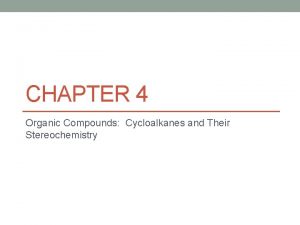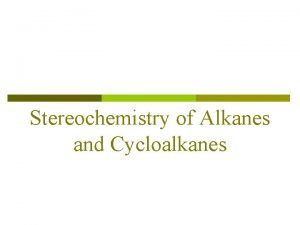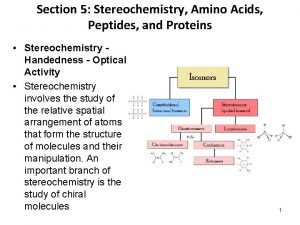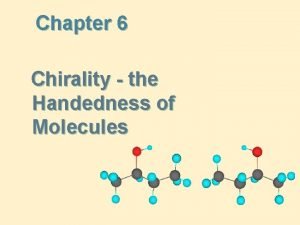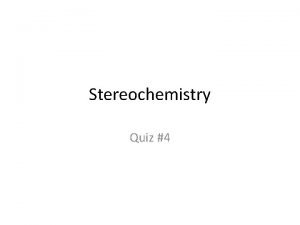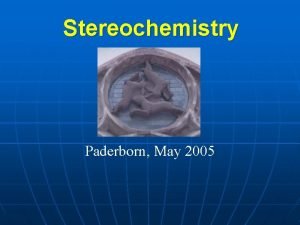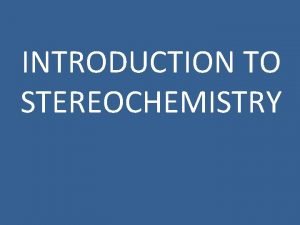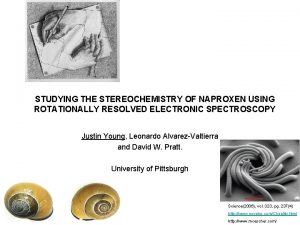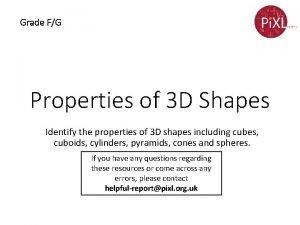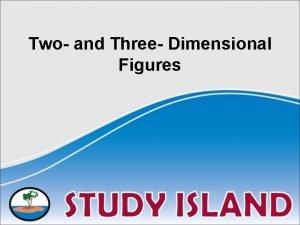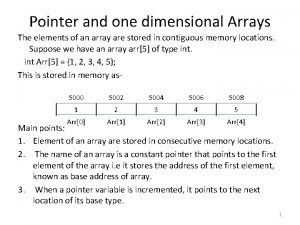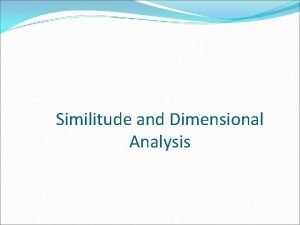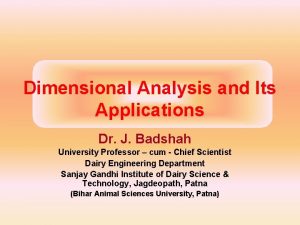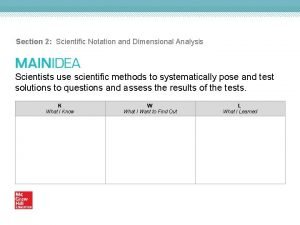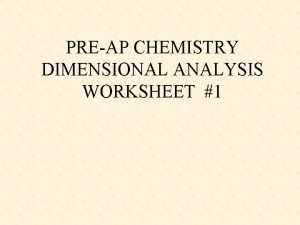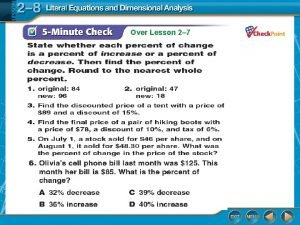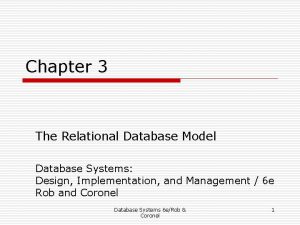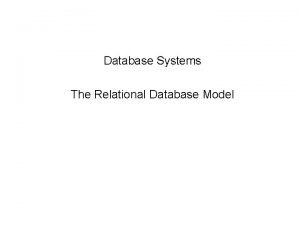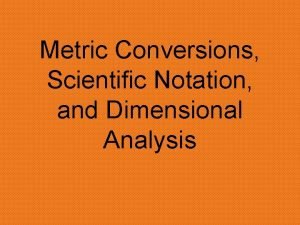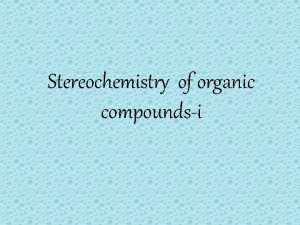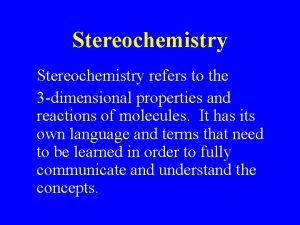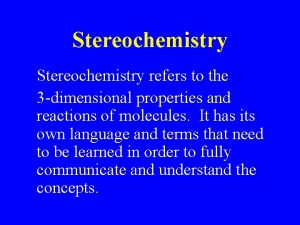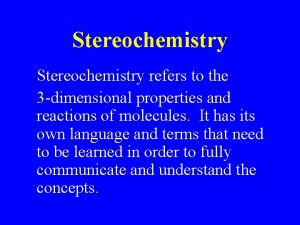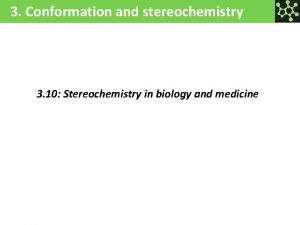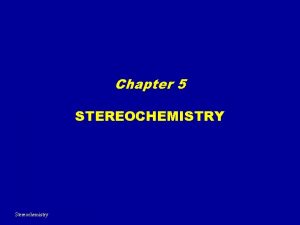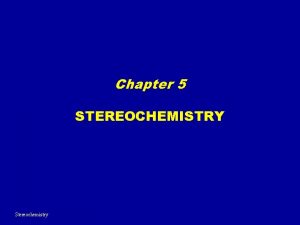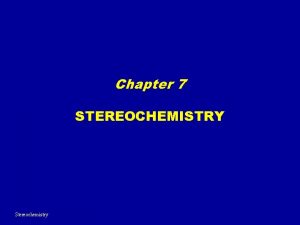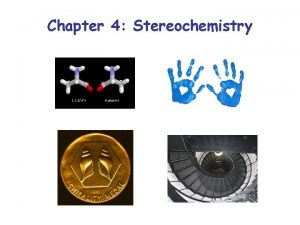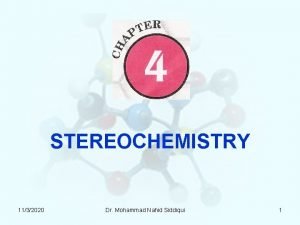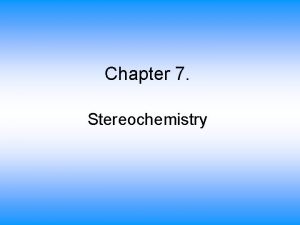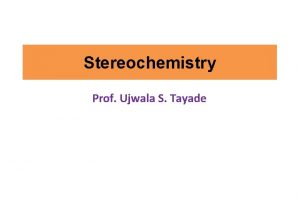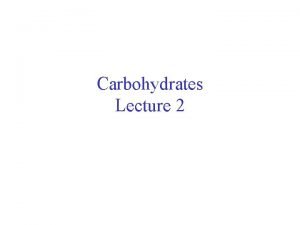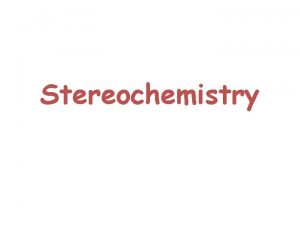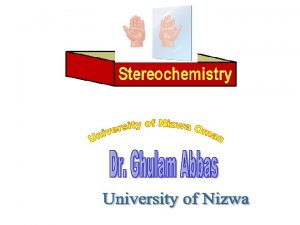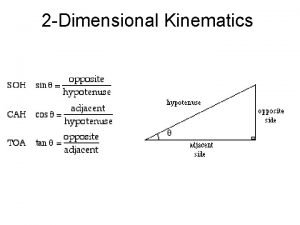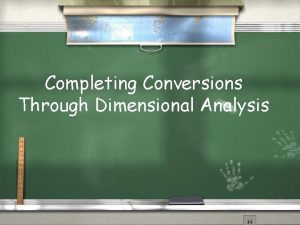Stereochemistry refers to the 3 dimensional properties and


































































- Slides: 66

Stereochemistry refers to the 3 -dimensional properties and reactions of molecules. It has its own language and terms that need to be learned in order to fully communicate and understand the concepts. © 2013 Pearson Education, Inc.

Definitions • Stereoisomers – compounds with the same connectivity, different arrangement in space • Enantiomers – stereoisomers that are nonsuperimposible mirror images; only properties that differ are direction (+ or -) of optical rotation • Diastereomers – stereoisomers that are not mirror images; different compounds with different physical properties © 2013 Pearson Education, Inc.

More Definitions • Asymmetric center – sp 3 carbon with 4 different groups attached • Optical activity – the ability to rotate the plane of plane –polarized light • Chiral compound – a compound that is optically active (achiral compound will not rotate light) • Polarimeter – device that measures the optical rotation of the chiral compound © 2013 Pearson Education, Inc.

Chirality • “Handedness”: Right-hand glove does not fit the left hand. • An object is chiral if its mirror image is different from the original object. © 2013 Pearson Education, Inc. Chapter 5 4

Achiral • Mirror images that can be superposed are achiral (not chiral). © 2013 Pearson Education, Inc. Chapter 5 5

Stereoisomers Enantiomers: Compounds that are nonsuperimposable mirror images. Any molecule that is chiral must have an enantiomer. © 2013 Pearson Education, Inc. Chapter 5 6

Chiral Carbon Atom • Also called asymmetric carbon atom. • Carbon atom that is bonded to four different groups is chiral. • Its mirror image will be a different compound (enantiomer). © 2013 Pearson Education, Inc. Chapter 5 7

Stereocenters • An asymmetric carbon atom is the most common example of a chirality center. • Chirality centers belong to an even broader group called stereocenters. A stereocenter (or stereogenic atom) is any atom at which the interchange of two groups gives a stereoisomer. • Asymmetric carbons and the double-bonded carbon atoms in cis-trans isomers are the most common types of stereocenters. © 2013 Pearson Education, Inc. Chapter 5 8

Examples of Chirality Centers Asymmetric carbon atoms are examples of chirality centers, which are examples of stereocenters. © 2013 Pearson Education, Inc. Chapter 5 9

© 2013 Pearson Education, Inc.

Achiral Compounds Take this mirror image and try to superimpose it on the one to the left matching all the atoms. Everything will match. When the images can be superposed, the compound is achiral. © 2013 Pearson Education, Inc. Chapter 5 11

Planes of Symmetry • A molecule that has a plane of symmetry is achiral. © 2013 Pearson Education, Inc. Chapter 5 12

Cis Cyclic Compounds • Cis-1, 2 -dichlorocyclohexane is achiral because the molecule has an internal plane of symmetry. Both structures above can be superimposed (they are identical to their mirror images). © 2013 Pearson Education, Inc. Chapter 5 13

Trans Cyclic Compounds • Trans-1, 2 -dichlorocyclohexane does not have a plane of symmetry so the images are nonsuperimposable and the molecule will have two enantiomers. © 2013 Pearson Education, Inc. Chapter 5 14

(R) and (S) Configuration • Both enantiomers of alanine receive the same name in the IUPAC system: 2 -aminopropanoic acid. • Only one enantiomer is biologically active. In alanine only the enantiomer on the left can be metabolized by the enzyme. • A way to distinguish between them is to use stereochemical modifiers (R) and (S). © 2013 Pearson Education, Inc. Chapter 5 15

Cahn–Ingold–Prelog Priority System • Enantiomers have different spatial arrangements of the four groups attached to the asymmetric carbon. • The two possible spatial arrangements are called configurations. • Each asymmetric carbon atom is assigned a letter (R) or (S) based on its three-dimensional configuration. • Cahn–Ingold–Prelog convention is the most widely accepted system for naming the configurations of chirality centers. © 2013 Pearson Education, Inc. Chapter 5 16

(R) and (S) Configuration: Step 1 Assign Priority • Assign a relative “priority” to each group bonded to the asymmetric carbon. Group 1 would have the highest priority, group 2 second, etc. • Atoms with higher atomic numbers receive higher priorities. I > Br > Cl > S > F > O > N > © 2013 Pearson Education, Inc. Chapter 5 13 C > 12 C > 2 H > 1 H 17

Assign Priorities Atomic number: © 2013 Pearson Education, Inc. F > N > C > H Chapter 5 18

(R) and (S) Configuration: Breaking Ties In case of ties, use the next atoms along the chain of each group as tiebreakers. © 2013 Pearson Education, Inc. Chapter 5 19

(R) and (S) Configuration: Multiple Bonds Treat double and triple bonds as if each were a bond to a separate atom. © 2013 Pearson Education, Inc. Chapter 5 20

(R) and (S) Configuration: Step 2 • Working in 3 -D, rotate the molecule so that the lowest priority group is in back. • Draw an arrow from highest (1) to second highest (2) to lowest (3) priority group. • Clockwise = (R), Counterclockwise = (S) © 2013 Pearson Education, Inc. Chapter 5 21

Assign Priorities Counterclockwise ( S) Draw an arrow from Group 1 to Group 2 to Group 3 and back to Group 1. Ignore Group 4. Clockwise = (R) and Counterclockwise = (S) © 2013 Pearson Education, Inc. Chapter 5 22

Example Clockwise ( R) When rotating to put the lowest priority group in the back, keep one group in place and rotate the other three. © 2013 Pearson Education, Inc. Chapter 5 23

Example (Continued) 3 1 4 2 Counterclockwise (S) © 2013 Pearson Education, Inc. Chapter 5 24

Configuration in Cyclic Compounds © 2013 Pearson Education, Inc. Chapter 5 25

Properties of Enantiomers • Same boiling point, melting point, and density. • Same refractive index. • Rotate the plane of polarized light in the same magnitude, but in opposite directions. • Different interaction with other chiral molecules: – Active site of enzymes is selective for a specific enantiomer. – Taste buds and scent receptors are also chiral. Enantiomers may have different smells. © 2013 Pearson Education, Inc. Chapter 5 26

Polarized Light Plane-polarized light is composed of waves that vibrate in only one plane. © 2013 Pearson Education, Inc. Chapter 5 27

Optical Activity • Enantiomers rotate the plane of polarized light in opposite directions, but same number of degrees. © 2013 Pearson Education, Inc. Chapter 5 28

Polarimeter Counterclockwi se Clockwise Dextrorotatory (+) Levorotatory (-) Not related to (R) and (S) © 2013 Pearson Education, Inc. Chapter 5 29

Specific Rotation Observed rotation depends on the length of the cell and concentration, as well as the strength of optical activity, temperature, and wavelength of light. [ ] = (observed) c l Where (observed) is the rotation observed in the polarimeter, c is concentration in g/m. L, and l is length of sample cell in decimeters. © 2013 Pearson Education, Inc. Chapter 5 30

Solved Problem 2 When one of the enantiomers of 2 -butanol is placed in a polarimeter, the observed rotation is 4. 05° counterclockwise. The solution was made by diluting 6 g of 2 -butanol to a total of 40 m. L, and the solution was placed into a 200 -mm polarimeter tube for the measurement. Determine the specific rotation for this enantiomer of 2 -butanol. Solution Since it is levorotatory, this must be (–)-2 -butanol The concentration is 6 g per 40 m. L = 0. 15 g/m. L, and the path length is 200 mm = 2 dm. The specific rotation is [a] 25 D = © 2013 Pearson Education, Inc. – 4. 05° (0. 15)(2) Chapter 5 = – 13. 5° 31

Biological Discrimination © 2013 Pearson Education, Inc. Chapter 5 32

Biological Activity © 2013 Pearson Education, Inc.

SSRI Efficacy depends on Stereochemistry © 2013 Pearson Education, Inc.

Racemic Mixtures • • Equal quantities of d- and l-enantiomers. Notation: (d, l) or ( ) No optical activity. The mixture may have different boiling point (b. p. ) and melting point (m. p. ) from the enantiomers! © 2013 Pearson Education, Inc. Chapter 5 35

Racemic Products If optically inactive reagents combine to form a chiral molecule, a racemic mixture is formed. © 2013 Pearson Education, Inc. Chapter 5 36

Optical Purity • Optical purity (o. p. ) is sometimes called enantiomeric excess (e. e. ). • One enantiomer is present in greater amounts. o. p. = © 2013 Pearson Education, Inc. observed rotation of pure enantiomer Chapter 5 X 100 37

Calculate % Composition The specific rotation of (S)-2 -iodobutane is +15. 90. Determine the % composition of a mixture of (R)and (S)-2 -iodobutane if the specific rotation of the mixture is -3. 18. Sign is from the enantiomer in excess: levorotatory. o. p. = 3. 18 15. 90 2 l = 120% © 2013 Pearson Education, Inc. X 100 = 20% l = 60% Chapter 5 d = 40% 38

Chirality of Conformers • If equilibrium exists between two chiral conformers, the molecule is not chiral. • Judge chirality by looking at the most symmetrical conformer. • Cyclohexane can be considered to be planar, on average. © 2013 Pearson Education, Inc. Chapter 5 39

Chirality of Conformational Isomers The two chair conformations of cis-1, 2 -dibromocyclohexane are nonsuperimposable, but the interconversion is fast and the molecules are in equilibrium. Any sample would be racemic and, as such, optically inactive. © 2013 Pearson Education, Inc. Chapter 5 40

Nonmobile Conformers • The planar conformation of the biphenyl derivative is too sterically crowded. The compound has no rotation around the central C—C bond and thus it is conformationally locked. • The staggered conformations are chiral: They are nonsuperimposable mirror images. © 2013 Pearson Education, Inc. Chapter 5 41

Allenes can be Chiral © 2013 Pearson Education, Inc.

Penta-2, 3 -diene Is Chiral © 2013 Pearson Education, Inc. Chapter 5 43

Fischer Projections • Flat representation of a 3 -D molecule. • A chiral carbon is at the intersection of horizontal and vertical lines. • Horizontal lines are forward, out of plane. • Vertical lines are behind the plane. © 2013 Pearson Education, Inc. Chapter 5 44

Fischer Projections (Continued) © 2013 Pearson Education, Inc. Chapter 5 45

Fischer Rules • Carbon chain is on the vertical line. • Highest oxidized carbon is at top. • Rotation of 180 in plane doesn’t change molecule. • Rotation of 90 is NOT allowed. © 2013 Pearson Education, Inc. Chapter 5 46

180° Rotation • A rotation of 180° is allowed because it will not change the configuration. © 2013 Pearson Education, Inc. Chapter 5 47

90° Rotation • A 90° rotation will change the orientation of the horizontal and vertical groups. • Do not rotate a Fischer projection 90°. © 2013 Pearson Education, Inc. Chapter 5 48

Glyceraldehyde • The arrow from group 1 to group 2 to group 3 appears counterclockwise in the Fischer projection. If the molecule is turned over so the hydrogen is in back, the arrow is clockwise, so this is the (R) enantiomer of glyceraldehyde. © 2013 Pearson Education, Inc. Chapter 5 49

When naming (R) and (S) from Fischer projections with the hydrogen on a horizontal bond (toward you instead of away from you), just apply the normal rules backward. © 2013 Pearson Education, Inc. Chapter 5 50

Fischer Mirror Images • Fisher projections are easy to draw and make it easier to find enantiomers and internal mirror planes when the molecule has two or more chiral centers. CH 3 H Cl Cl H CH 3 © 2013 Pearson Education, Inc. Chapter 5 51

Fischer (R) and (S) • Lowest priority (usually H) comes forward, so assignment rules are backward! • Clockwise 1 -2 -3 is (S) and counterclockwise 1 -2 -3 is (R). • Example: CH 3 (S) © 2013 Pearson Education, Inc. H Cl Cl H (S) CH 3 Chapter 5 52

Racemic Mixture © 2013 Pearson Education, Inc.

Meso Compound Internal Plane of Symmetry Optically Inactive © 2013 Pearson Education, Inc.

Diastereomers: Cis-trans Isomerism on Double Bonds • These stereoisomers are not mirror images of each other, so they are not enantiomers. They are diastereomers. © 2013 Pearson Education, Inc. Chapter 5 55

Diastereomers: Cis-trans Isomerism on Rings • Cis-trans isomers are not mirror images, so these are diastereomers. © 2013 Pearson Education, Inc. Chapter 5 56

Diastereomers • Molecules with two or more chiral carbons. • Stereoisomers that are not mirror images. © 2013 Pearson Education, Inc. Chapter 5 57

Two or More Chiral Carbons • When compounds have two or more chiral centers they have enantiomers, diastereomers, or meso isomers. • Enantiomers have opposite configurations at each corresponding chiral carbon. • Diastereomers have some matching, some opposite configurations. • Meso compounds have internal mirror planes. • Maximum number of isomers is 2 n, where n = the number of chiral carbons. © 2013 Pearson Education, Inc. Chapter 5 58

2, 3, 4 -trichlorohexane How many stereoisomers? © 2013 Pearson Education, Inc.

n = 3; 2 n = 8 © 2013 Pearson Education, Inc.

A Carbohydrate © 2013 Pearson Education, Inc.

Meso Compounds • Meso compounds have a plane of symmetry. • If one image was rotated 180°, then it could be superimposed on the other image. • Meso compounds are achiral even though they have chiral centers. © 2013 Pearson Education, Inc. Chapter 5 62

Number of Stereoisomers The 2 n rule will not apply to compounds that may have a plane of symmetry. 2, 3 -dibromobutane has only three stereoisomers: (±) diastereomer and the meso diastereomer. © 2013 Pearson Education, Inc. Chapter 5 63

Properties of Diastereomers • Diastereomers have different physical properties, so they can be easily separated. • Enantiomers differ only in reaction with other chiral molecules and the direction in which polarized light is rotated. • Enantiomers are difficult to separate. • Convert enantiomers into diastereomers to be able to separate them. © 2013 Pearson Education, Inc. Chapter 5 64

Chemical Resolution of Enantiomers React the racemic mixture with a pure chiral compound, such as tartaric acid, to form diastereomers, then separate them. © 2013 Pearson Education, Inc. Chapter 5 65

Formation of (R)- and (S)-2 Butyl Tartrate © 2013 Pearson Education, Inc. Chapter 5 66
 Cyclopentane cis trans isomers
Cyclopentane cis trans isomers Stereochemistry of alkanes and cycloalkanes
Stereochemistry of alkanes and cycloalkanes A circular motion is one dimensional
A circular motion is one dimensional Example of denatured protein
Example of denatured protein R vs s stereochemistry
R vs s stereochemistry Indicate the relationship of the pair of molecules shown.
Indicate the relationship of the pair of molecules shown. Father of stereochemistry
Father of stereochemistry Chiral vs achiral
Chiral vs achiral Naproxen stereochemistry
Naproxen stereochemistry Stereochemistry of cephalosporins
Stereochemistry of cephalosporins Finding stereocenters
Finding stereocenters 3d shape diagram
3d shape diagram Difference between intensive and extensive properties
Difference between intensive and extensive properties Chemical property of water
Chemical property of water Hát kết hợp bộ gõ cơ thể
Hát kết hợp bộ gõ cơ thể Slidetodoc
Slidetodoc Bổ thể
Bổ thể Tỉ lệ cơ thể trẻ em
Tỉ lệ cơ thể trẻ em Gấu đi như thế nào
Gấu đi như thế nào Chụp phim tư thế worms-breton
Chụp phim tư thế worms-breton Hát lên người ơi alleluia
Hát lên người ơi alleluia Các môn thể thao bắt đầu bằng tiếng chạy
Các môn thể thao bắt đầu bằng tiếng chạy Thế nào là hệ số cao nhất
Thế nào là hệ số cao nhất Các châu lục và đại dương trên thế giới
Các châu lục và đại dương trên thế giới Cong thức tính động năng
Cong thức tính động năng Trời xanh đây là của chúng ta thể thơ
Trời xanh đây là của chúng ta thể thơ Mật thư tọa độ 5x5
Mật thư tọa độ 5x5 Phép trừ bù
Phép trừ bù độ dài liên kết
độ dài liên kết Các châu lục và đại dương trên thế giới
Các châu lục và đại dương trên thế giới Thơ thất ngôn tứ tuyệt đường luật
Thơ thất ngôn tứ tuyệt đường luật Quá trình desamine hóa có thể tạo ra
Quá trình desamine hóa có thể tạo ra Một số thể thơ truyền thống
Một số thể thơ truyền thống Cái miệng nó xinh thế chỉ nói điều hay thôi
Cái miệng nó xinh thế chỉ nói điều hay thôi Vẽ hình chiếu vuông góc của vật thể sau
Vẽ hình chiếu vuông góc của vật thể sau Thế nào là sự mỏi cơ
Thế nào là sự mỏi cơ đặc điểm cơ thể của người tối cổ
đặc điểm cơ thể của người tối cổ V. c c
V. c c Vẽ hình chiếu đứng bằng cạnh của vật thể
Vẽ hình chiếu đứng bằng cạnh của vật thể Phối cảnh
Phối cảnh Thẻ vin
Thẻ vin đại từ thay thế
đại từ thay thế điện thế nghỉ
điện thế nghỉ Tư thế ngồi viết
Tư thế ngồi viết Diễn thế sinh thái là
Diễn thế sinh thái là Các loại đột biến cấu trúc nhiễm sắc thể
Các loại đột biến cấu trúc nhiễm sắc thể Bảng số nguyên tố
Bảng số nguyên tố Tư thế ngồi viết
Tư thế ngồi viết Lời thề hippocrates
Lời thề hippocrates Thiếu nhi thế giới liên hoan
Thiếu nhi thế giới liên hoan ưu thế lai là gì
ưu thế lai là gì Khi nào hổ con có thể sống độc lập
Khi nào hổ con có thể sống độc lập Sự nuôi và dạy con của hổ
Sự nuôi và dạy con của hổ Sơ đồ cơ thể người
Sơ đồ cơ thể người Từ ngữ thể hiện lòng nhân hậu
Từ ngữ thể hiện lòng nhân hậu Thế nào là mạng điện lắp đặt kiểu nổi
Thế nào là mạng điện lắp đặt kiểu nổi Sin 37
Sin 37 Two and three dimensional figures
Two and three dimensional figures Pointer and one dimensional array
Pointer and one dimensional array Similitude analysis
Similitude analysis Dimensional analysis and its applications
Dimensional analysis and its applications Dimensional analysis with scientific notation
Dimensional analysis with scientific notation Dimensional analysis worksheet chemistry
Dimensional analysis worksheet chemistry 2-7 literal equations and dimensional analysis
2-7 literal equations and dimensional analysis Two-dimensional structure composed of rows and columns
Two-dimensional structure composed of rows and columns Two-dimensional structure composed of rows and columns
Two-dimensional structure composed of rows and columns Metric conversion scientific notation
Metric conversion scientific notation
